
Carex flacca, with common names blue sedge, gray carex, glaucous sedge, or carnation-grass,, is a species of sedge native to parts of Europe and North Africa. It is frequent in a range of habitats, including grasslands, moorlands, exposed and disturbed soil, and the upper edges of salt marshes. It has naturalized in eastern North America.
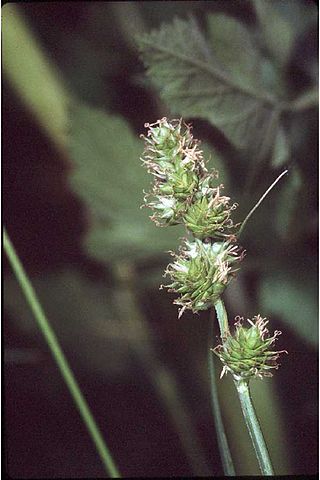
Carex molesta is a species of sedge known by the common name troublesome sedge. It is native to eastern and central North America, where it grows in varied wet and dry habitats, performs equally well in full sun and partial shade, including disturbed areas such as roadsides. It is an introduced species and often a weed in California.
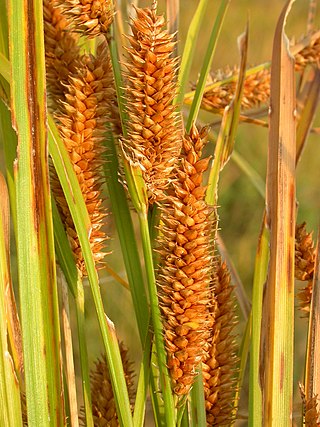
Carex utriculata is a species of sedge known as Northwest Territory sedge and common yellow lake sedge.
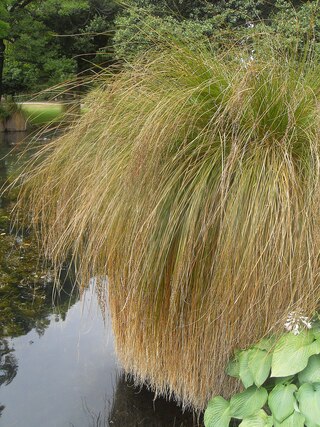
Carex secta is a sedge from the Cyperaceae family that is endemic to New Zealand. It grows in wetlands. Its Māori names include purei, pukio and makura.

Carex specuicola is a rare species of sedge known by the common name Navajo sedge. It is native to a small section of the Colorado Plateau in the United States, its distribution straddling the border between Utah and Arizona, and completely within the Navajo Nation. There are several populations but they are limited to a specific type of habitat. The plants grow from the sides of steep, often vertical cliffs of red Navajo Sandstone, in areas where water trickles from the rock. It occurs at elevations between 5,700 and 6,000 feet, usually in shady spots. Though it is not a grass, the sedge grows in inconspicuous clumps resembling tufts of grass sticking out of the rock face. When the sedge was federally listed as a threatened species in 1985, it was known from only three populations in Coconino County, Arizona, with no more than 700 plants existing. The species has since been observed in northeastern Arizona and San Juan County, Utah.

Carex riparia, the greater pond sedge, is a species of sedge found across Europe and Asia. It grows in a variety of wet habitats, and can be a dominant species in some swamps. It is Britain's largest Carex, growing up to 130 cm tall, with glaucous leaves up to 160 cm long. It hybridises with a number of other Carex species, including the closely related Carex acutiformis – the lesser pond sedge. A variegated cultivar is grown as an ornamental grass.
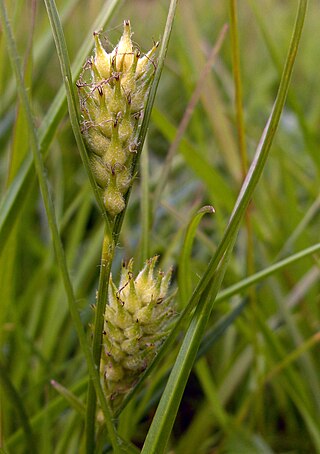
Carex hirta, the hairy sedge or hammer sedge, is a species of sedge native across Europe. It has characteristic hairy leaves and inflorescences, and is the type species of the genus Carex.

Carex binervis, the green-ribbed sedge, is a European species of sedge with an Atlantic distribution. It is found from Fennoscandia to the Iberian Peninsula, and occurs in heaths, moorland and other damp, acidic environments. It typically grows to a height of 15–120 cm (6–50 in), and has inflorescences comprising one male and several female spikes, each up to 45 mm (1.8 in) long. The utricles have two conspicuous green veins, which give rise to both the scientific name and the common name of the species. In the vegetative state, it closely resembles C. bigelowii, a species that usually grows at higher altitude. C. binervis was first described by James Edward Smith in 1800, and is classified in Carex sect. Spirostachyae; several hybrids with other Carex species are known.

Carex spicata is a species of sedge in the genus Carex.

Carex pilulifera, the pill sedge, is a European species of sedge found in acid heaths, woods and grassland from Macaronesia to Scandinavia. It grows up to 30 cm (12 in) tall, with 2–4 female spikes and 1 male spike in an inflorescence. These stalks bend as the seeds ripen, and the seeds are collected and dispersed by ants of the species Myrmica ruginodis.

Carex sylvatica is a species of sedge found in deciduous woodlands across Europe. It typically reaches 60 cm (24 in) tall, and has an inflorescence made up of 3–5 pendent female spikes and a single male spike. It is also used as a garden plant, and has been introduced to North America and New Zealand.

Carex lacustris, known as lake sedge, is a tufted grass-like perennial of the sedge family (Cyperaceae), native to southern Canada and the northern United States. C. lacustris us an herbaceous surface-piercing plant that grows in water up to 50 cm (1.6 ft) deep, and grows 50–150 cm (1.6–4.9 ft) tall. It grows well in marshes and swampy woods of the boreal forest, along river and lake shores, in ditches, marshes, swamps, and other wetland habitat. It grows on muck, sedge peat, wet sand or silt, in filtered or full sunlight.

Carex pseudocyperus is a species of flowering plant in the sedge family known by the common name cyperus sedge or hop sedge. It grows in marshes, swamps, and the margins of ponds, rivers and canals. The stems can be up to 90 centimetres (35 in) with one male spike and 3 to 5 pendulous female spikes, and bright yellow-green leaves to 1.2 metres.

Carex eburnea, known as ivory sedge, ebony sedge, and bristleleaf or bristle-leaved sedge, is a small and slender sedge native to North America, from Alaska and Newfoundland south to central Mexico.

Carex appressa, the tall sedge, is a species of flowering plant in the family Cyperaceae. It is native to New Guinea, Australia, New Zealand, and generally in the South West Pacific.

Carex sprengelii, known as Sprengel's sedge and long-beaked sedge, is a sedge with hanging seed heads, native to North America.
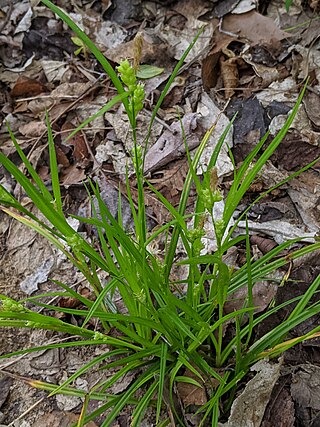
Carex blanda, the common woodland sedge or eastern woodland sedge, is a species of sedge native to a wide variety of habitats in the eastern and central United States and Canada.

Carex davisii, known as Davis' sedge or awned graceful sedge, is a species of Carex native to North America. It is listed as an endangered, threatened, or species of concern across much of edge of its range. It was named in the 1820s by Lewis David de Schweinitz and John Torrey in honor of Emerson Davis (1798–1866), a Massachusetts educator and "enthusiastic student of the genus" Carex.
Carex arctogena is a member of the sedge family (Cyperaceae) which grows in high alpine areas. It is one of the few "bipolar" species; it has populations in Greenland, Scandinavia, Russia, Canada and southern South America. Plants in the far north and south appear to be genetically identical, having taken advantage of a similar niches on opposite ends of the globe.

Carex baileyi is a sedge in section Vesicariae the genus Carex native to the Appalachian Mountains in Eastern North America. It is commonly called Bailey's sedge. Carex baileyi was named in honor of Liberty Hyde Bailey by its discoverer, Nathaniel_Lord_Britton.




















